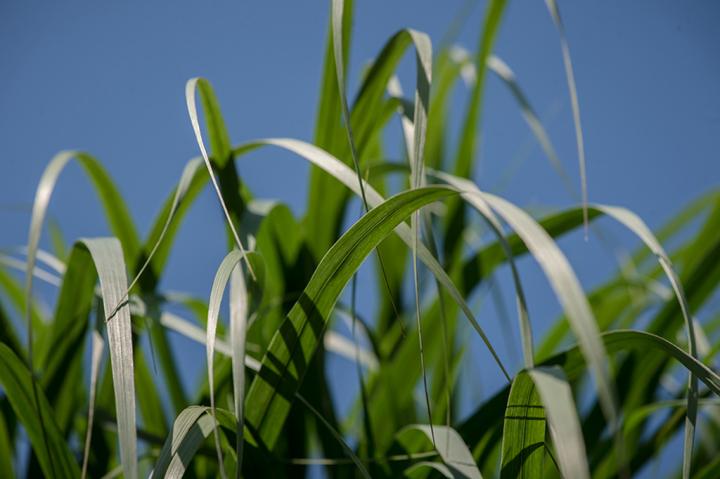
Credit: Courtesy of MSU
Switchgrass is attractive as a potential bioenergy crop because it can grow for years without having to be replanted. Requiring less fertilizer than typical annual crops like corn, switchgrass can keep more nitrogen, phosphorus and carbon in the soil and out of our air and waterways. But, unlike corn, breeding of switchgrass for optimal traits is still in its early stages.
Now, in a collaboration with the U.S Department of Energy, or DOE, the Joint Genome Institute, a DOE Office of Science User Facility, and the University of Texas at Austin, Great Lakes Bioenergy Research Center researchers at Michigan State University have identified specific parts of genetic code within the plant that could contribute to larger switchgrass harvests while reducing potential crop weaknesses.
David Lowry, assistant professor of plant biology at MSU, and Thomas Juenger, professor of integrative biology at UT Austin, led a team that identified genes that boost switchgrass growth across a wide range of climates – and that these plants can be bred to include these genetic markers.
Additionally, the researchers found that some adaptive traits in switchgrass can often be improved without hurting plant health in other ways. The results of this study were published this week in the Proceedings of the National Academy of Sciences.
Like many domesticated plants, switchgrass has multiple cultivars adapted to different geographic regions. Northern upland switchgrass typically lives on ridgelines and in prairie areas in states such as South Dakota, Michigan, and Wisconsin. This breed does not mind the cold and can survive harsh winters, as is the case with many things from the north.
However, northern switchgrass does not grow as large or as quickly as the southern lowland ecotype that thrives in wet, marshy areas from Missouri and Kansas down to Texas. The southern cultivar also tends to be more pest-resistant and can better withstand extreme conditions such as drought and flooding. The southern ecotype, on the other hand, does not tolerate cold winters, often dying off when the weather turns too chilly.
To try and get the best of both worlds, Lowry, Juenger and their partners devised an experiment across the central United States – from Texas to South Dakota – to determine what loci cause differences between the varieties adapted to cold northern areas versus hot southern areas.
“We’re interested in how often loci that improve performance in some sites (say in the south) come at a cost or tradeoff for performance at other locations (say in the north),” Juenger said. “The 10 sites were mainly chosen to involve people we’d met or had interacted with in the switchgrass community over the past few years – and cover the latitudinal distribution of the species. We’ve really tried to build the field plantings as a community resource.”
First, they created a crossbreed of the two varieties, then planted hundreds of the same switchgrass hybrid in 10 locations covering the entire geographical region. Then, comparing growth of the hybrids to the parent cultivars at each site, the researchers isolated the genetic cause of beneficial outcomes using an approach called quantitative trait locus, or QTL, mapping.
The southern variety is generally a larger grass, so researchers have often thought its loci would be solely responsible for increasing the size of hybrids. Surprisingly, the experiment revealed that northern switchgrass gene play a role in increased biomass as well.
“This means if we can combine those genomes together through hybridization, we can actually get a much higher-yielding plant,” said Lowry.
Genetic adaptation often comes with tradeoffs. For example, traits that confer winter hardiness in the north might divert resources from growth. Similarly, the prevalence of growth genes in southern-adapted plants might reduce their cold tolerance.
In this study, advantageous characteristics for growth were expressed in one region of the country without others being diminished. “That tells us a little bit about how adaptation works and how it could provide a benefit for agriculture,” said Lowry. “If we can select on these loci, we can get a benefit without much of cost.”
Because they designed the study to cover such a broad geographical area, the group could isolate these win/win genetic scenarios.
“Usually there’s only two field sites involved in these types of experiments, but we had 10,” Lowry said. “So we had a much better idea that there were these loci that have much lower costs associated with them.”
“We’re getting new insights into how plants adjust in different environments,” Lowry said. “Understanding how switchgrass adapts to the northern U.S. versus the southern U.S. will allow us to use that knowledge to improve it as a bioenergy crop.”
###
This research was supported by the U.S. Department of Energy, Office of Science, Office of Biological and Environmental Research award number DE-SC0014156 to TEJ and DE-SC0017883 to DBL. Funding was provided by a National Science Foundation Plant Genome Research Program Awards (IOS-0922457 and IOS-1444533) to TEJ and NSF/IOS-1402393 to JTL. This research was also based upon work supported in part by the Great Lakes Bioenergy Research Center, U.S. Department of Energy, Office of Science, Office of Biological and Environmental Research under Award Numbers DE-SC0018409 and DE-FC02-07ER64494. The work conducted by the U.S. Department of Energy Joint Genome Institute is supported by the Office of Science of the U.S. Department of Energy under Contract No. DE-AC02-05CH11231. We thank the Joint Genome Institute and collaborators for prepublication access to the Panicum virgatum AP13 genome reference.
Media Contact
Layne Cameron
[email protected]
Related Journal Article
http://dx.




